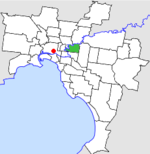- City of Kew
-
City of Kew
Victoria
Location in MelbournePopulation: 28,900 (1992)[1] Established: 1860 Area: 14.56 km² (5.6 sq mi) Council Seat: Kew Region: Melbourne County: Bourke LGAs around City of Kew: Northcote Heidelberg Doncaster & Templestowe Collingwood City of Kew Camberwell Richmond Hawthorn Camberwell The City of Kew was a Local Government Area located about 4 kilometres (2.5 mi) east of Melbourne, the state capital of Victoria, Australia, on the southeast bank of the Yarra River. The city covered an area of 14.56 square kilometres (5.62 sq mi), and existed from 1860 until 1994.
Contents
History
Kew was first incorporated as a municipal district on 19 December 1860, becoming a borough in October 1863 and a town on 8 December 1910. It was proclaimed a City on 10 March 1921.[2]
On 22 June 1994, the City of Kew was abolished and merged into the newly-created City of Boroondara along with the Cities of Hawthorn and Camberwell.[3]
The council met at the Kew Town Hall at Cotham Road and Charles Street, Kew.
Wards
Kew was divided into four wards on 27 August 1955, each electing three councillors:
- Prospect Ward
- Sackville Ward
- Studley Park Ward
- Willsmere Ward
Geography
The council area covered the suburbs of Kew and Kew East, and was bounded by the Yarra River to the north and west, Barkers Road to the south and Burke Road to the east.[4]
Population
Year Population 1861 1,439 1891 8,462 1921 17,382 1947 30,859 1954 31,518 1958 32,700* 1961 33,341 1966 32,801 1971 32,564 1976 29,683 1981 28,870 1986 28,162 1991 27,291 * Estimate in the 1958 Victorian Year Book.
References
- ^ Australian Bureau of Statistics, Victoria Office (1994). Victorian Year Book. p. 49. ISSN 0067-1223.
- ^ Victorian Municipal Directory. Brunswick: Arnall & Jackson. 1992. pp. 406–407. Accessed at State Library of Victoria, La Trobe Reading Room.
- ^ Australian Bureau of Statistics (1 August 1995). Victorian local government amalgamations 1994-1995: Changes to the Australian Standard Geographical Classification. Commonwealth of Australia. p. 4. ISBN 0-642-23117-6. http://www.ausstats.abs.gov.au/ausstats/free.nsf/0/76E601D6DB55E88ACA25722500049195/$File/12570_1994-95.pdf. Retrieved 2007-12-16.
- ^ Melway - Greater Melbourne Street Directory (22nd edition). Glen Iris, Victoria: Melway Publishing Pty Ltd. 1993. pp. Maps 44–45. ISSN 0311-3957.
Former Local Government Areas in Melbourne, Victoria Altona · Berwick · Box Hill · Brighton · Broadmeadows · Brunswick · Bulla (S) · Camberwell · Caulfield · Chelsea · Coburg · Collingwood · Cranbourne · Croydon · Diamond Valley (S) · Doncaster & Templestowe · Dandenong · Eltham (S) · Essendon · Fitzroy · Flinders (S) · Footscray · Frankston · Hastings (S) · Hawthorn · Healesville (S) · Heidelberg · Keilor · Kew · Lillydale (S) · Malvern · Moorabbin · Mordialloc · Mornington (S) · Northcote · Nunawading · Oakleigh · Pakenham (S) · Port Melbourne · Prahran · Preston · Richmond · Ringwood · Sandringham · Sherbrooke (S) · South Melbourne · Springvale · St Kilda · Sunshine · Upper Yarra (S) · Waverley · Werribee · Williamstown
Categories:- Former Local Government Areas of Victoria (Australia)
Wikimedia Foundation. 2010.
